Keep Hummingbirds Warm and Safe: A Comprehensive Guide And Cool Tips
If you want to keep hummingbirds warm and safe you need to protect their food source from freezing. Here where I live in Canada at this time of the year in January there are no flowers to feed on. The temperatures dipped down to minus 17 in the last few days. I have spent the whole day trading out the feeders because they kept freezing over. And every time I switched the feeders I was scaring them away 🙁 In years past I was against putting out a feeder and heater…20 years ago you just didn’t see hummers at this time of the year because they had migrated south for the winter.
My Quest To Keep Their Nectar From Freezing
But they are now here year-round. And I love the little buggars and want to help them through the winter. I went onto Amazon hoping to get a heater, but it wouldn’t be here in time. The cold snap isn’t going to be here long. Hummingbirds need food especially in the morning and just before dark at this time of the year to sustain themselves. So I went to my local bird store and found a heater. Yes, it was expensive…but it works, and they are worth it! The nectar has been fine now for the last two days. It’s worth it to me because I now don’t have to worry about them not getting any food.
Understanding Hummingbirds and Their Behavior
Appreciating the Diverse Species of Hummingbirds
There are over 300 recognized species of hummingbirds worldwide, each unique in their color patterns, sizes, feeding, and mating habits. Birds like the Sword-billed Hummingbird and Bee Hummingbird each hold fascinating adaptabilities – the former boasts a beak longer than itself, and the latter, is the smallest bird species globally. These nectar-feeding birds are remarkably adaptable to varied climates from lofty Andean mountains soaring above 14,000 feet to low-lying tropical forests. Their adaptability has been key to their evolutionary success, leaving us with a diverse array of species to appreciate.
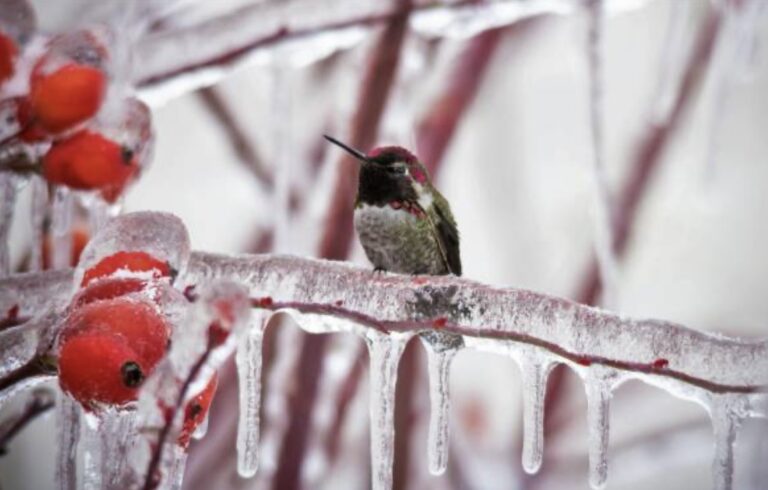
Grasping the Hummingbird's Seasons and Migration
Interested in why your backyard hummers seem to appear and disappear with the seasons? Not all hummingbird species migrate, but those that do – such as the Ruby-throated Hummingbird – have journey patterns linked with seasonal changes, notably when food sources diminish.
Generally, they spend winters in warmer regions like Central America, returning to the North and Canada for the summer breeding season. These migrations are impacted by weather conditions, such as freezing temperatures and heavy rainfalls, which can delay or derail migration routes. But as previously mentioned they can still be here in the winter. I notice it more in the heat of the summer that the feeder is not as busy, because they have gone farther North.
Deciphering the Daily Habits of Hummingbirds
Knowing the unique feeding, breeding, nesting, and social practices gives us insight into keeping these creatures safe and warm.
An average hummingbird may visit hundreds of flowers daily to meet their high-energy diet. During the breeding season, they build tiny nests using plant materials secured with spider silk, allowing the nest to expand as the chicks grow.
Hummingbirds are mostly solitary, and while males have a role in mating, females take on nest-building and chick-rearing responsibilities.
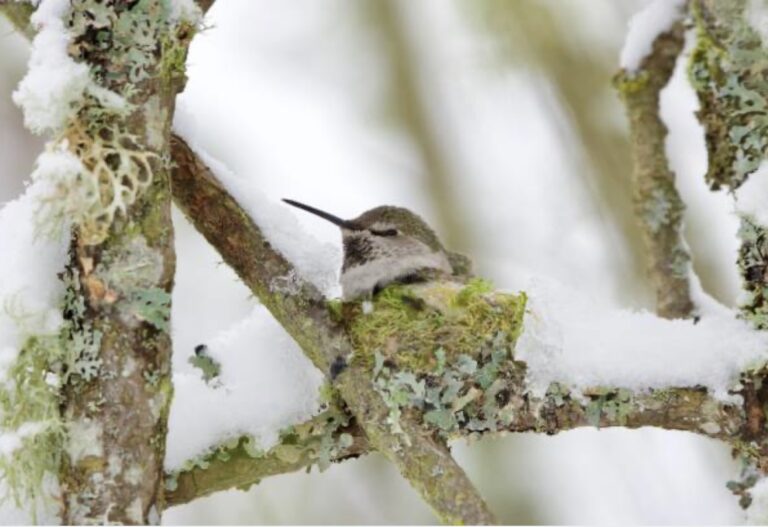
Recognizing the Importance of Warmth: Why Hummingbirds Need Warmth
Extreme body temperatures, particularly cold, can be harmful to hummingbirds. Their exceedingly high metabolism – the fastest of any vertebrate – requires them to consume large amounts of nectar daily. Low temperatures force these creatures into a state of torpor, a deep sleep-like state that slows their metabolic rate to conserve energy.
Signs a Hummingbird Might be Cold
Cold weather could lead to unusual behavior in hummingbirds, like lethargy, lack of appetite, or difficulty flying. Physical signs might include fluffed-out feathers or an overly still posture – a possible indicator of entering torpor. Prolonged cold exposure can lead to hypothermia and eventual death.
The Vulnerability of Hummingbirds to Cold Weather
The hummingbird’s small size and high metabolism make them vulnerable to cold weather fluctuations. Their survival depends on their ability to maintain a steady body temperature. Cold snaps can prove deadly, depriving them of nectar-rich flowers, and causing them to use up their energy reserves quickly.
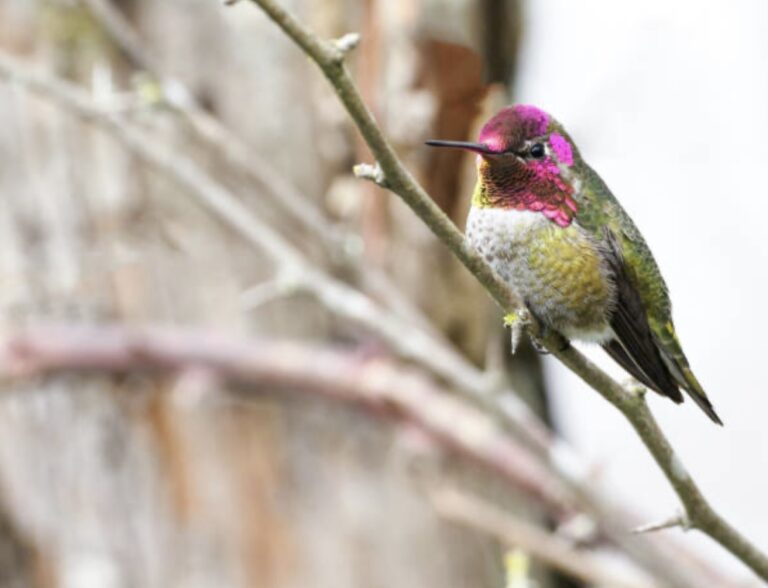
Setting Up Safe and Warm Environments for Hummingbirds
Designing Hummingbird-Friendly Gardens
Creating a garden that provides adequate food and shelter can go a long way in supporting hummingbirds. Planting native, nectar-rich flowers and providing multiple levels of perching spots can help provide the necessary warmth and safety. Windbreaks and dense foliage can offer refuge from cold temperatures and prevailing winds. You can also provide them refuge on a small patio. I’m in an apartment and I love having them visit.
Effective Use of Feeders
Feeders are crucial, especially in seasons when natural food sources are scarce. They should be cleaned, filled regularly, and placed away from prevailing winds and predators, preferably near a window for easy observation. Heated feeders can also be used during winter to prevent nectar from freezing.
Empowering with Man-Made Shelters
Birdhouses do not attract hummingbirds. Instead, consider structures like windbreaks and weather shields, or even small heating elements (safely installed), that can bring added warmth.
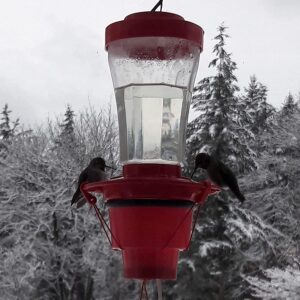
Emergency Care and Measures for Cold-Stricken Hummingbirds
Recognizing Critical Situations
Professional wildlife rehabilitators should handle serious situations. However, understanding when intervention is necessary can help save a hummingbird’s life.
An At-home Care Guide for Cold-struck Hummingbirds
If a hummingbird is visibly struggling, it may be necessary to take temporary measures. Bringing them indoors to a quiet, warm space can help. Providing sugar water can replenish energy reserves.
Promoting Hummingbird Conservation Efforts
Promote conservation efforts in your community to safeguard hummingbird populations, which can involve creating warm shelters and advocating for protective local wildlife conservation laws.
Misconceptions About Keeping Hummingbirds Warm
Debunking Common Myths
Many myths can harm hummingbirds, such as the belief that leaving out feeders prevents migration. This is not true; other signals like daylight length trigger migratory behavior.
The Reality Check – Do’s and Don’ts
Avoiding harm while trying to help is essential. For example, never use honey, artificial sweeteners, or red dye when making nectar for hummingbirds.
Progress Toward Humane Practices
Human understanding and practice are always evolving. The continued promotion, research, and development of hummingbird conservation methods contribute significantly to humane practices. We always want our tiniest feathered friends to be safe and happy.
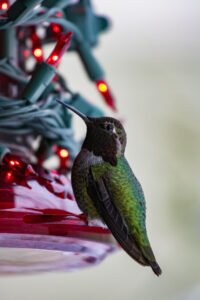
Light Up Your Garden: Use Christmas Lights to Keep Hummingbird Feeders from Freezing
Are you a hummingbird enthusiast trying to figure out how to keep your feed from freezing as the cold weather approaches? As winter rolls around, many garden lovers face this dilemma. But did you know that Christmas lights can be a festive and practical solution?
Shimmering Solution: Christmas Lights to the Rescue!
Seasonal changes can make feeding hummingbirds a bit of a challenge. When the temperature drops, the nectar in the feeders can freeze, making it inaccessible for these tiny birds. However, you can ditch the worry because a simple yet effective solution is at hand – Christmas lights!
We all know that holiday lights can create a warm, festive atmosphere. The lesser-known fact is that they can generate enough heat to keep a hummingbird feeder from freezing. Placing these twinkling wonders around your feeders is not just a visually appealing solution but also a practical one.

Taking Advantage of the Holidays
You might be wondering – why Christmas lights? Most Christmas lights heat up enough to prevent the nectar in the feeders from solidifying. This is because they generate a small amount of heat when turned on. Because hummingbird feeders are typically made of glass, this nominal heat is sufficient to keep the nectar free-flowing through frosty nights.
Before using this method, always check the bulbs to ensure they are not dangerously hot. It’s safer to use the traditional string lights as they emit less heat, compared to lights like LEDs which don’t heat up at all, and therefore, won’t keep the nectar from freezing.
Step-by-Step: The Perfect Warm Wrap
Setting up the Christmas lights around your hummingbird feeder is easy and fun! Here’s what you need to do:
Obtain a safe set of Christmas lights.
Carefully wrap the lights around the feeder. Try not to cover the feeding ports.
Make sure the lights are evenly spread, as this will equally distribute the heat.
Plug in the lights, especially during freezing nights.
But remember, safety comes first. Ensure the lights and cord are weatherproof or they are set up in a covered area. Always double-check everything is safe and functioning properly.
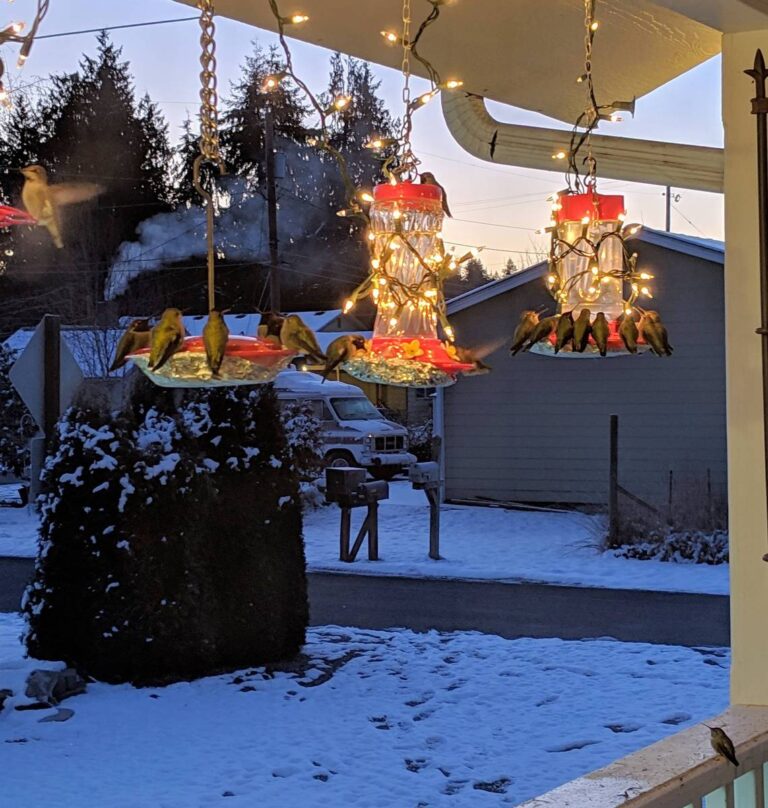
Wrap-Up: Bright Feeding Spots For Winter
Keeping hummingbird feeders from freezing does not have to be a daunting task. All you need is a sparkling string of Christmas lights to ensure your backyard tweeters have access to their food source, even on the chilliest of winter nights. It’s a win-win, right? Your garden will be bathed in a warm, magical glow and the hummingbirds will thank you for their unfrozen feast!
So, as you unpack those twinkling lights for the holidays, don’t forget to wrap up a hummingbird feeder or two. Your feathered friends will greatly appreciate it! Nothing beats having a unique and heart-warming hummingbird display that spreads cheer both to people and birds alike.
Whether you’re new to birdfeeding or have been doing it for years, this brilliant solution can help you provide for hummingbirds all year round. So, why not give it a try? Your charming, feathered visitors will surely keep coming back for more!
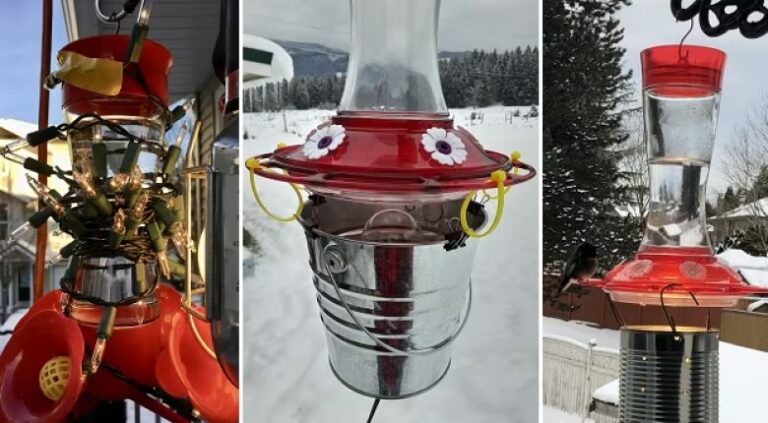
The Reward of Providing Warmth and Safety
Providing images of these movements can inspire others to create hospitable spaces for these wonderful creatures. By valuing their survival and understanding their needs, we can cohabit in the same spaces harmoniously. As well as Christmas lights people have also used grow mats for seeds to keep food from freezing. Ice cream pails and light bulbs, heating cords for plastic pipes, the list goes on. Go down the YouTube rabbit hole and you will find numerous solutions that your little hummingbird friends will thank you for.
Frequently Asked Questions
This question is often asked by individuals who are new to hummingbird feeding. They may be curious about whether a heater is necessary or if hummingbirds can thrive without one in colder temperatures. If The nectar is freezing, you need one.
People often want to understand the mechanics behind these heaters. This question may involve inquiries about the type of technology used, power sources, and how the heater prevents the nectar from freezing in cold weather.
Hummingbirds have specific temperature preferences, and users may wonder when it’s necessary to start using a heater. It’s simple to see when you need the heater, when ice starts to form that’s when you should start using it. Before it’s frozen solid.
There are many ways to heat your feeder, a trip to your local bird store or browsing on Amazon will show you all the different options. I prefer to shop locally personally.
Commercial heaters are quite expensive for the materials they use. (I’m Scottish and entitled to my opinion lol) Again I highly suggest going down the rabbit hole of YouTube, lots of creative folks on there.
The same way you normally do, keep the sugar water fresh and clean it regularly. Just take the heater off first.


